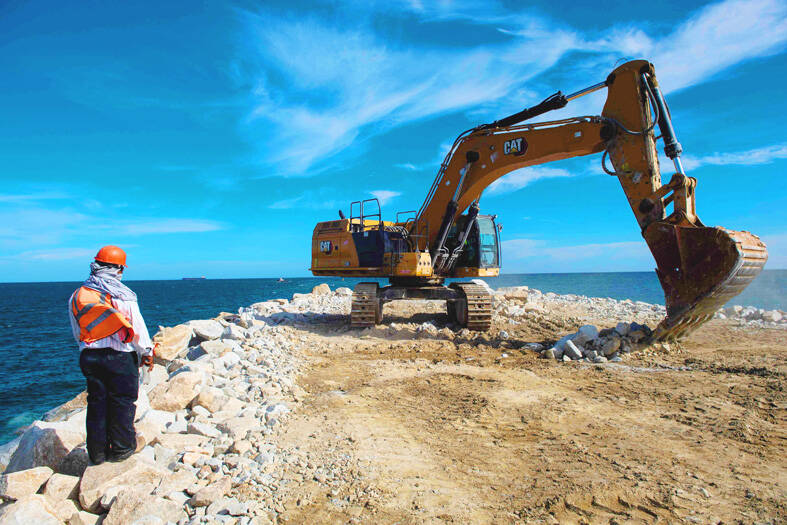At Mexico’s narrowest point, linking the Pacific and Atlantic oceans, the government is building a railway rival to the Panama Canal with promises of economic bounty, but amid fears of environmental and social harm.
The Spanish conquistador Hernan Cortes already dreamed of such a crossing for humans and goods in the 16th century, but most plans came to naught and a prior, rudimentary connection was all but abandoned with the opening of the canal cutting through Panama in 1914.
Then, in 2020, work started on a new coast-to-coast link under the government of Mexican President Andres Manuel Lopez Obrador.

Photo: AFP
It comprises a 300km railway line from the Pacific port of Salina Cruz to Coatzacoalcos on the other side of the Isthmus of Tehuantepec — a region rich in biodiversity and Indigenous heritage.
The government has announced an investment of US$2.85 billion.
Project coordinator Adiel Estrada said it has created 800 direct jobs and about 2,400 indirect ones — a much-needed injection for that part of the country.
Officials expect that once fully operational, by 2033, the “interoceanic corridor” would boost GDP by 3 to 5 percentage points.
“We will go ... from one ocean to the other in seven hours,” Lopez Obrador boasted of the project in a recent video recorded aboard a brand-new train.
Service is expected to start in December with two daily round-trips for passengers, and three for cargo.
By 2028, the Isthmus of Tehuantepec Interoceanic Corridor (CIIT) should have 300,000 cargo containers transiting every year, with 1.4 million by 2033. The 80km Panama Canal moved about 63.2 million tons last year.
Lopez Obrador has said the CIIT comes at a time that “our brothers in Panama are having difficulties due to water shortages” in the canal through which three percent of global maritime trade passes.
The Panama Canal Authority has had to reduce traffic to 25 ships per day starting Nov. 3 — down from 39 per day on average last year. By mid-February it would be down to 20 per day.
The Mexican corridor would be accompanied by the development of industrial parks, which the government hopes will attract about US$7 billion in investment.
However, the corridor has had a mixed response.
“It’s a magnificent project,” said Angelica Gonzalez, a 42-year-old craftswoman from Ciudad Ixtepec, one of the stops on the new route she hopes will boost sales to tourists.
Gonzalez was five years old when she last took a passenger train linking the two coasts.
That line was fully operational from 1907 to the 1950s, then declined until the 1990s when it finally closed, leaving only one cargo train on the route.
The cargo service has long been in urgent need of an update as Mexico upgrades capacity at its Atlantic and Pacific ports and the CIIT is meant to do just that.
Salina Cruz green activist Rafael Mayoral said that people along the route are “very motivated” for its opening.
Yet he said that “does not erase its environmental and social impact.”
According to another activist, Juana Ramirez of the Union of Indigenous Communities in the Northern Zone of the Isthmus (UCIZONI) non-governmental organization, the isthmus was likely to become polluted and downgraded by the project, with trees felled and vegetation uprooted.
The UCIZONI says communities were not adequately consulted on the project, and that several people have been displaced.
Ramirez said locals were being “harassed.”
She herself faces a large fine — yet to be determined by a court — for taking part in a protest against the CIIT.
Activists also fear a rise of violence in the area with organized crime likely to grow as access improves.
By the middle of next year, the train is meant to link up to another line to the border with Guatemala via Mexico’s Chiapas state — a gateway for US-bound migrants without travel documents who frequently fall victim to smuggling gangs.
Observers also say that gangs are seizing land near the railway lines — uprooting residents — as they expect its value to rise.
The Mexican Center for Environmental Law non-governmental organization recorded three murders of land activists between October last year and July that it said were linked to the corridor.

Application-specific integrated circuit designer Faraday Technology Corp (智原) yesterday said that although revenue this quarter would decline 30 percent from last quarter, it retained its full-year forecast of revenue growth of 100 percent. The company attributed the quarterly drop to a slowdown in customers’ production of chips using Faraday’s advanced packaging technology. The company is still confident about its revenue growth this year, given its strong “design-win” — or the projects it won to help customers design their chips, Faraday president Steve Wang (王國雍) told an online earnings conference. “The design-win this year is better than we expected. We believe we will win

Intel Corp chief executive officer Lip-Bu Tan (陳立武) is expected to meet with Taiwanese suppliers next month in conjunction with the opening of the Computex Taipei trade show, supply chain sources said on Monday. The visit, the first for Tan to Taiwan since assuming his new post last month, would be aimed at enhancing Intel’s ties with suppliers in Taiwan as he attempts to help turn around the struggling US chipmaker, the sources said. Tan is to hold a banquet to celebrate Intel’s 40-year presence in Taiwan before Computex opens on May 20 and invite dozens of Taiwanese suppliers to exchange views

Chizuko Kimura has become the first female sushi chef in the world to win a Michelin star, fulfilling a promise she made to her dying husband to continue his legacy. The 54-year-old Japanese chef regained the Michelin star her late husband, Shunei Kimura, won three years ago for their Sushi Shunei restaurant in Paris. For Shunei Kimura, the star was a dream come true. However, the joy was short-lived. He died from cancer just three months later in June 2022. He was 65. The following year, the restaurant in the heart of Montmartre lost its star rating. Chizuko Kimura insisted that the new star is still down

While China’s leaders use their economic and political might to fight US President Donald Trump’s trade war “to the end,” its army of social media soldiers are embarking on a more humorous campaign online. Trump’s tariff blitz has seen Washington and Beijing impose eye-watering duties on imports from the other, fanning a standoff between the economic superpowers that has sparked global recession fears and sent markets into a tailspin. Trump says his policy is a response to years of being “ripped off” by other countries and aims to bring manufacturing to the US, forcing companies to employ US workers. However, China’s online warriors